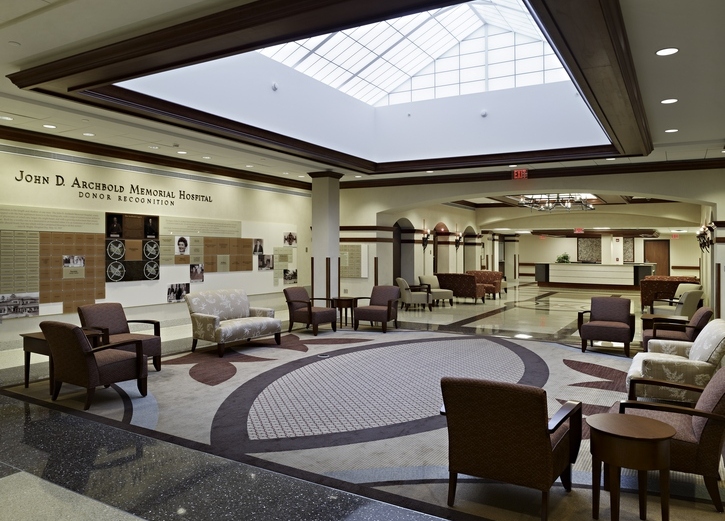 The GS&P-designed Sarasota Memorial Hospital patient tower features a lobby characterized by open, airy spaces that feel welcoming and transparent. Photo courtesy of Gresham, Smith and Partners.
The GS&P-designed Sarasota Memorial Hospital patient tower features a lobby characterized by open, airy spaces that feel welcoming and transparent. Photo courtesy of Gresham, Smith and Partners.
 GS&P's interior design at John D. Archbold Memorial Hospital balances traditional Georgian décor with Archbold’s signature Mediterranean style, incorporating sophisticated, valuable elements like wood and stone accents, terrazzo flooring and unique, iron light fixtures fabricated by local metals artist Fred Eubanks. Photo courtesy of Stanley Capps.
GS&P's interior design at John D. Archbold Memorial Hospital balances traditional Georgian décor with Archbold’s signature Mediterranean style, incorporating sophisticated, valuable elements like wood and stone accents, terrazzo flooring and unique, iron light fixtures fabricated by local metals artist Fred Eubanks. Photo courtesy of Stanley Capps.
Subscribe Now
Branded Environments: Seamlessly Connecting Healthcare Providers with Patients
By Phillip Petty
In the healthcare world, it is critical for providers to connect with patients in order to gain their trust and establish confidence in their brand. And while many providers are successful in developing and executing complex marketing and advertising campaigns, branded environments are an opportunity for communication and connection that sometimes gets overlooked. But what, exactly, is a branded environment? The answer is complex.
First, it’s important to understand a company’s big-picture goals in order to help create physical spaces filled with elements that support those goals. A successful branded environment improves brand positioning and effective communication by helping customers better understand the companies and organizations with which they interact.
No matter the industry, the strongest, most desirable brands can be identified by their logo. Mercedes, Starbucks and Target are a few examples where a symbol alone – no words necessary – evokes a powerful feeling about the company and its image. The logo is the consistent vehicle available at each and every “touch point” a customer experiences – whether the logo is placed on a website, highlighted in an advertising campaign or showcased on a product or in an environment.
Digging deeper, it’s the brand attributes that support the logo and defines the brand. These brand attributes have strong functional and emotional associations assigned by consumers. Tangible visual aspects might include a “connection to nature” that is brought to life as abstract patterns designed in the architecture or organic materials incorporated throughout the interior of a space. Non-tangible attributes like “honesty and transparent” might be communicated with design features like open spaces and vision glass.
In the healthcare world, branded environments and brand attributes provide patients with a clearer idea of who their provider is and what their provider stands for. It is the branded environment that adds clarity and credibility to messages directed toward customers and the community. Let’s take a closer look at each of the qualities associated with a successful environment:
Memorable
Without doubt, a healthcare company’s brand must be worth remembering. A generic-looking logo, an unremarkable entrance and interior spaces with no personality, a wayfinding system with no cohesion—all of these missed opportunities add up to a forgettable brand. Every company is unique, and the environment should communicate that originality whenever the chance is available. The sights, sounds and overall experience of a facility should be designed in a way that always stands out and never risks getting lost in the shuffle of competitors.
Consistent
Brand attributes create consistency. As healthcare providers grow and merge with other providers, it is essential that brands remain consistent. Consistency builds loyalty to and advocacy for strong brands, resulting in enthusiastic and passionate customers. Elements of a “warm and inviting” brand attribute for a multi-location healthcare company could include visual aspects such as a fireplace in each location’s reception lobby, or a specified, recognizable material such as stone or wood. Brand consistency can extend into other elements such as linens in patient rooms, staff apparel, name badges, patient collateral and wall graphics. Even if none of these features include the logo, their consistent use becomes part of the company’s story.
Valuable
Branded healthcare environments should support an elevated perceived value of a company. A strong healthcare brand will encourage patients to pay for the intangible benefits they get from associating themselves with that brand. Associations between the environment and the brand help build trust in the healthcare provider in the mind of a patient, leading to confidence they will receive the highest quality of care and service. The aforementioned lobby fireplace reminds patients of the comfort and coziness of home, a very positive association that will trump a competing organization that is associated with feelings of tension or coldness. Dining facilities, pharmacies and gift shops can also play a role, as they become brands within a brand, adding a valued service for patients and guests and offering additional sources of revenue for providers.
Branded environments integrate visuals, messages and values into the built environment, helping companies and organizations tell the right stories to their intended audiences. As the healthcare industry becomes increasingly competitive, branded environments offer providers the opportunity to rise above the competition with elements that are consistent and memorable, reliably adding value to a company and creating loyal customers.
Author: Phillip Petty
Phillip Petty is a leader in experiential branding, with nearly two decades of experience using architectural conceptual design and 3-D design elements like signage, large-scale graphics and exhibits to achieve results for a variety of companies and organizations. He leads the Branded Environments practice at Gresham, Smith and Partners.
Tags: Architecture, Branding
Posted September 14, 2015
More Articles:
- State of Industry Examined in ‘Healthcare Reset’ Report
- Cam Twohey Joins Kahler Slater as Associate Principal, Senior Project Architect in Healthcare Market
- Perkins Eastman Welcomes Michael Hess as Principal in New York Studio
- Guerin Children’s Inpatient Pediatric Unit at Cedars-Sinai Provides Interactive, Family Friendly Healing Environment
- Coverings 2024
Apr 22, 2024 – Apr 25, 2024 - Hospital, Outpatient Facilities & Medical Office Buildings Summit
Apr 25, 2024 – Apr 25, 2024 - CxA Workshop & Exam
Apr 29, 2024 – Apr 30, 2024 - EMP Seminar & Exam at CxEnergy 2024
Apr 29, 2024 – Apr 30, 2024 - CxEnergy
Apr 29, 2024 – May 2, 2024 - PHCC West 2024
Apr 29, 2024 – May 2, 2024 - Lean in Design Forum 2024
May 1, 2024 – May 2, 2024










